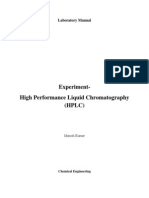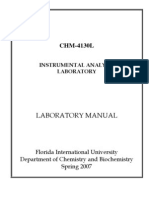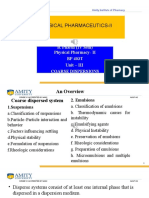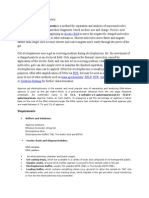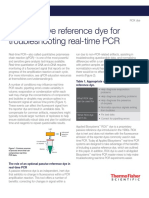Temperature Programming in GC
Uploaded by
nealmatsumotoTemperature Programming in GC
Uploaded by
nealmatsumotoTemperature programming in GC
Training course on GC/MS Nha Trang 13-18/10 2008 Charlotta Rylander
Separation of compounds by GC
In GC, analytes are separated according to boiling point and polarity and other properties. The boiling point affect how easily the analytes evaporate. Molecules with low boiling point will elute early from the GC column, hence, compounds with high boiling point will elute late. Analytes interact with the GC column. If the column is non-polar, analytes with high polarity will travel fast through the column while more non-polar compounds will be retained.
Temperature effects
Temperature
Vapour pressure of analytes
Partitioning coefficient
Retention time
Isothermal column temperature
If the GC is run isothermally, the column temperature is constant throughout the analysis. Fast eluting compounds may then appear as overlapping peaks and late eluting compounds will have long retention time and broad peak shape. Isothermal GC is not a good choice for samples containing analytes with varying boiling points.
http://ull.chemistry.uakron.edu/chemsep/slide.php?Ch apter=/chemsep/GC/&Last=100&Slide=56
Temperature programming
By increasing the temperature as a function of time, it is possible to separate mixtures with various boiling point and still have good chromatography. In addition, the total analysis time will be shorter.
http://ull.chemistry.uakron.edu/chemsep/slide.php?Ch apter=/chemsep/GC/&Last=100&Slide=56
Isothermal GC temperature/ Temperature programming
Isotherm column temperature
Temperature programming
www.chem.agilent.com
Setting up a temperature program
Trial and error technique!
Setting up a temperature program
Try to find publications about analysis of the analytes of interest. Usually, the temperature program is reported. Useful internet sites:
http://chromatographyonline.findpharma.com/lcgc/
http://spectroscopymag.findpharma.com/spectrosco py
Setting up a temperature program
Always use standard solutions when setting up a temperature program. The injector temperature must be optimized before start. If the injector temperature is too low, the analytes will not be vaporized. If it is too high, we may loose analytes. Check boiling point of analytes before start. Ramp temperature on column when optimizing injector temperature. Take care when using on column detector. Check the boiling point of solvents and solvent mixtures.
http://www.cartage.org.lb/en/themes/Sciences/Chemist ry/Analyticalchemistry/MethodsInstrumentation/Chrom atography/Gaschromatography/splitinj.gif
Setting up a temperature program
Start with ramping the temperature (50C-300C, 510C/min, depending on analytes) to make sure you elute all compounds. From that run it is possible to determine the final temperature of the GC programme. Identify possible coelutions. In areas with coelutions, add isothermal periods. Initial temperature should be determined based on best possible separation of the the first few peaks. Experiment with various ramps between initial and final temperature to get the best separation and shortest method.
You might also like
- List of Essential Equipment For Vaccine Production Facility - 2021100% (1)List of Essential Equipment For Vaccine Production Facility - 20214 pages
- Amity Institute of Pharmacy: B Pharm Ist Semester Pharmaceutical Analysis Pawan Kumar GuptaNo ratings yetAmity Institute of Pharmacy: B Pharm Ist Semester Pharmaceutical Analysis Pawan Kumar Gupta35 pages
- Pharmaceutical Quality Assurance Practical I PDF100% (2)Pharmaceutical Quality Assurance Practical I PDF2 pages
- Principles of Analytical Method Validation100% (2)Principles of Analytical Method Validation34 pages
- Optimization Techniques in Pharmaceutical Formulation KiranNo ratings yetOptimization Techniques in Pharmaceutical Formulation Kiran22 pages
- Biological Test and Assay of Human Anti Hemophilic Vaccine and Rabies VaccineNo ratings yetBiological Test and Assay of Human Anti Hemophilic Vaccine and Rabies Vaccine31 pages
- Study of Consolidation Parameters NotesNo ratings yetStudy of Consolidation Parameters Notes19 pages
- Quality Control Tests For Containers, Closures and Secondary Packing Materials67% (3)Quality Control Tests For Containers, Closures and Secondary Packing Materials14 pages
- Biopharmaceutics & Pharmacokinetics Practical ManualNo ratings yetBiopharmaceutics & Pharmacokinetics Practical Manual74 pages
- Seminar On X-Ray Crystallography: Presented by Mounik Rout M.Pharm (PH - Technology) Guided by Dr. Sasmita Kumari AcharjyaNo ratings yetSeminar On X-Ray Crystallography: Presented by Mounik Rout M.Pharm (PH - Technology) Guided by Dr. Sasmita Kumari Acharjya31 pages
- Scale Up & Post Approval Changes: (Supac)No ratings yetScale Up & Post Approval Changes: (Supac)15 pages
- MPharm Pharmaceutical Quality AssuranceNo ratings yetMPharm Pharmaceutical Quality Assurance29 pages
- Qualification of UV - Visible Spectrophotometer100% (1)Qualification of UV - Visible Spectrophotometer15 pages
- Calibration of Uv Visible SpectrophotometerNo ratings yetCalibration of Uv Visible Spectrophotometer15 pages
- Prep. of Buffers Solutions Indian Pharmacopoeia 1996100% (2)Prep. of Buffers Solutions Indian Pharmacopoeia 19969 pages
- Assay of Calcium Gluconate by Complexometry75% (4)Assay of Calcium Gluconate by Complexometry2 pages
- AP PGECET Pharmacy Question Paper & Answer Key Download85% (27)AP PGECET Pharmacy Question Paper & Answer Key Download16 pages
- Physical Pharmaceutics-Ii: B. Pharm (IV Sem) Physical Pharmacy-II BP 403T Unit - III Coarse DispersionsNo ratings yetPhysical Pharmaceutics-Ii: B. Pharm (IV Sem) Physical Pharmacy-II BP 403T Unit - III Coarse Dispersions10 pages
- Techniques For The Study of Crystal PropertiesNo ratings yetTechniques For The Study of Crystal Properties11 pages
- Jurnal Kimia Mulawarman, Vol.8, No.2 (2011), Hal. 70-73No ratings yetJurnal Kimia Mulawarman, Vol.8, No.2 (2011), Hal. 70-737 pages
- University of Venda: Name: Madzivhandila LutendoNo ratings yetUniversity of Venda: Name: Madzivhandila Lutendo7 pages
- Rathore A.S., Velayudhan A. - Scale-Up and Optimization in Preparative Chromatography Principles and Biopharmaceutical Applications (2003)No ratings yetRathore A.S., Velayudhan A. - Scale-Up and Optimization in Preparative Chromatography Principles and Biopharmaceutical Applications (2003)346 pages
- Cell ViabilityTesting With Trypan Blue Exclusion MethodNo ratings yetCell ViabilityTesting With Trypan Blue Exclusion Method2 pages
- Instant download Protein Electrophoresis Methods and Protocols 1st Edition Oliver Smithies (Auth.) pdf all chapter100% (5)Instant download Protein Electrophoresis Methods and Protocols 1st Edition Oliver Smithies (Auth.) pdf all chapter50 pages
- Extraction of Sugars From Black Gram Peels by Reversed-Phase Liquid Chromatography Systems and Identification by TLC and Mass AnalysisNo ratings yetExtraction of Sugars From Black Gram Peels by Reversed-Phase Liquid Chromatography Systems and Identification by TLC and Mass Analysis5 pages
- Kod One PCR Master Mix Kod One PCR Master Mix - Blue-: TM TMNo ratings yetKod One PCR Master Mix Kod One PCR Master Mix - Blue-: TM TM15 pages
- Sodium Reagent Kit (Mono Test) : Colorimetric MethodNo ratings yetSodium Reagent Kit (Mono Test) : Colorimetric Method1 page
- 03-broschure_benchmark_special_stains_product_guid_241212_085811No ratings yet03-broschure_benchmark_special_stains_product_guid_241212_08581144 pages
- جهاز-تحليل-كيمياء-الدم-الاتوميشن-AGD-1600No ratings yetجهاز-تحليل-كيمياء-الدم-الاتوميشن-AGD-16002 pages
- List of Essential Equipment For Vaccine Production Facility - 2021List of Essential Equipment For Vaccine Production Facility - 2021
- Amity Institute of Pharmacy: B Pharm Ist Semester Pharmaceutical Analysis Pawan Kumar GuptaAmity Institute of Pharmacy: B Pharm Ist Semester Pharmaceutical Analysis Pawan Kumar Gupta
- Optimization Techniques in Pharmaceutical Formulation KiranOptimization Techniques in Pharmaceutical Formulation Kiran
- Biological Test and Assay of Human Anti Hemophilic Vaccine and Rabies VaccineBiological Test and Assay of Human Anti Hemophilic Vaccine and Rabies Vaccine
- Quality Control Tests For Containers, Closures and Secondary Packing MaterialsQuality Control Tests For Containers, Closures and Secondary Packing Materials
- Biopharmaceutics & Pharmacokinetics Practical ManualBiopharmaceutics & Pharmacokinetics Practical Manual
- Seminar On X-Ray Crystallography: Presented by Mounik Rout M.Pharm (PH - Technology) Guided by Dr. Sasmita Kumari AcharjyaSeminar On X-Ray Crystallography: Presented by Mounik Rout M.Pharm (PH - Technology) Guided by Dr. Sasmita Kumari Acharjya
- Prep. of Buffers Solutions Indian Pharmacopoeia 1996Prep. of Buffers Solutions Indian Pharmacopoeia 1996
- AP PGECET Pharmacy Question Paper & Answer Key DownloadAP PGECET Pharmacy Question Paper & Answer Key Download
- Physical Pharmaceutics-Ii: B. Pharm (IV Sem) Physical Pharmacy-II BP 403T Unit - III Coarse DispersionsPhysical Pharmaceutics-Ii: B. Pharm (IV Sem) Physical Pharmacy-II BP 403T Unit - III Coarse Dispersions
- Jurnal Kimia Mulawarman, Vol.8, No.2 (2011), Hal. 70-73Jurnal Kimia Mulawarman, Vol.8, No.2 (2011), Hal. 70-73
- Rathore A.S., Velayudhan A. - Scale-Up and Optimization in Preparative Chromatography Principles and Biopharmaceutical Applications (2003)Rathore A.S., Velayudhan A. - Scale-Up and Optimization in Preparative Chromatography Principles and Biopharmaceutical Applications (2003)
- Cell ViabilityTesting With Trypan Blue Exclusion MethodCell ViabilityTesting With Trypan Blue Exclusion Method
- Instant download Protein Electrophoresis Methods and Protocols 1st Edition Oliver Smithies (Auth.) pdf all chapterInstant download Protein Electrophoresis Methods and Protocols 1st Edition Oliver Smithies (Auth.) pdf all chapter
- Extraction of Sugars From Black Gram Peels by Reversed-Phase Liquid Chromatography Systems and Identification by TLC and Mass AnalysisExtraction of Sugars From Black Gram Peels by Reversed-Phase Liquid Chromatography Systems and Identification by TLC and Mass Analysis
- Kod One PCR Master Mix Kod One PCR Master Mix - Blue-: TM TMKod One PCR Master Mix Kod One PCR Master Mix - Blue-: TM TM
- Sodium Reagent Kit (Mono Test) : Colorimetric MethodSodium Reagent Kit (Mono Test) : Colorimetric Method
- 03-broschure_benchmark_special_stains_product_guid_241212_08581103-broschure_benchmark_special_stains_product_guid_241212_085811



















